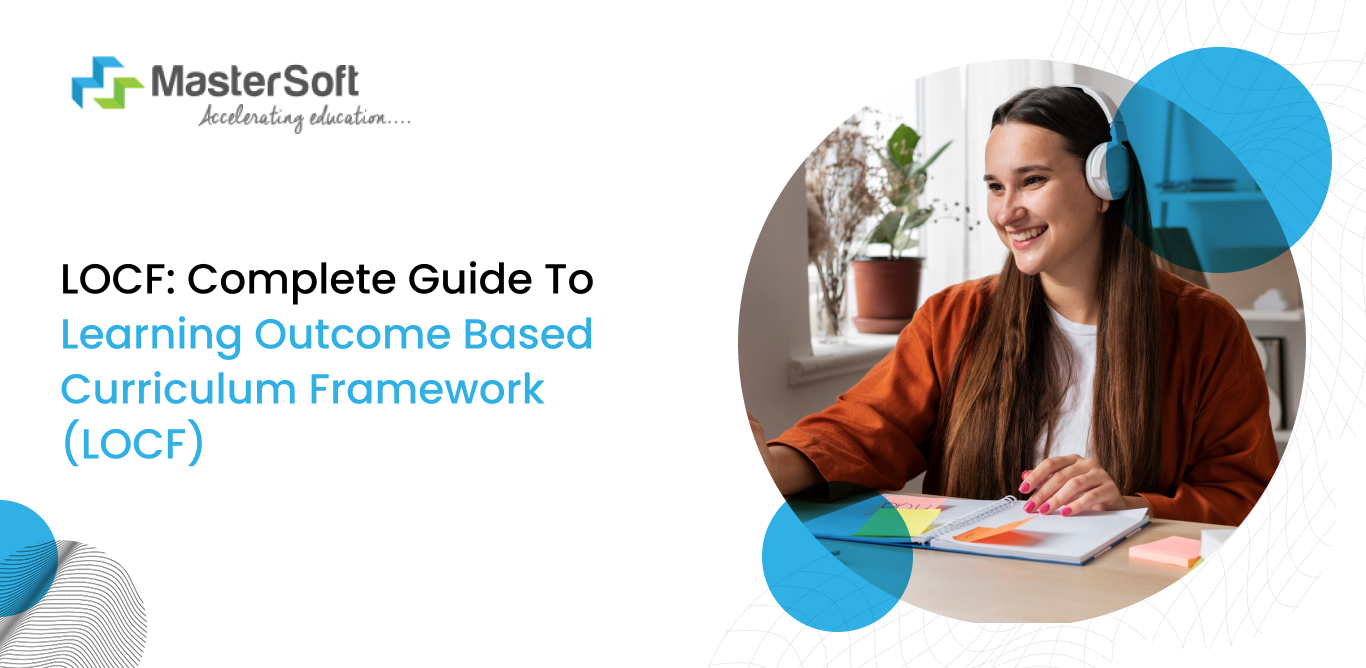05, February 2021
The University Grants Commission (UGC), one of the most prominent autonomous bodies that work towards ensuring the best quality education in India. As an initiative to make the teaching-learning framework better and enhance the student learning outcomes, the UGC has taken a thoughtful step by introducing the concept of LOCF - Learning Outcome Based Curriculum Framework.
The idea behind the implementation of LOCF in Indian institutions & universities is to pre-determine what outcomes need to be achieved by planning, mapping & measuring the student outcomes. It is quite similar to the concept of Outcome Based Education System. However, the major difference is that unlike the OBE framework, LOCF is implemented for the Choice Based Credit System (CBCS) for the undergraduate (UG) & postgraduate (PG) programs. The faculty needs to design a curriculum that would help students learn subjects of their interests while mapping their progress at every step.
The student learning outcomes would be defined in terms of their –
- Knowledge
- Skills
- Understanding
- Graduate Attributes
- Values
- Employability
Why Learning Outcome Based Curriculum Framework (LOCF)
The current education system in India is teacher-centric.
Right from the course curriculum to the assessment pattern, the faculty decides everything. To change the students, therefore, study just to obtain a decent score in examinations rather than thinking of their future & career perspective.
To improve students’ passion for learning news skills & adopting an innovative mindset, it's of utmost importance to incorporate the learning outcome based curriculum framework. The LOCF has tremendous potential to break the traditional teaching-learning barriers and make the education system student-centric.
Aim Of The Learning Outcome Based Curriculum Framework (LOCF)
The ultimate aim of LOCF lies in enhancing the quality of higher education in India and encouraging the students to gain the best skills & knowledge during their student journey. Learning outcomes are determined in sync with what students are expected to understand at the end of their study program.
The final expected student learning outcomes are considered as a reference to design the teaching-learning curriculum and graduate attributes. Once the final expected outcomes are defined clearly, teachers need to formulate a curriculum that would help them attain their goals. The curriculum intents to –
- Improve flexibility of learning
- Teaching-learning innovation
- Continuous teaching-learning improvements
- Assessment of students at various levels
- Periodic review of student performance
- Evaluating program learning outcomes (POs)
- Evaluating course learning outcomes (COs)
- Maintain highest standards of education
- Create an environment of global competitiveness
Learning Cycle Of The Learning Outcome Based Curriculum Framework (LOCF)
The learning cycle of the LOCF can be divided into the following three phases-
1) Planning Phase
In this phase, the faculty needs to set specific outcomes, design content & plan the content delivery & assessment strategies. This is the primary foundation that sets the entire journey hassle-free.
2) Execution Phase
The second phase focuses on delivering quality content in the best possible ways. The faculty needs to ensure that a proper curriculum is designed & delivered to students and also, prepare assessment papers that would help them map & measure the outcomes at every step.
Once the curriculum is defined, the faculty needs to decide various ways of delivering the content that could include the following -
- Traditional chalkboard method
- Online teaching & learning
- Video lectures or webinars
- Industrial projects
- Seminars & workshops
- Online assignments
- Field visits
Assessment & Question Paper Setting
In LOCF, the two modes of assessments need to be incorporated are: Direct & Indirect
Guide To Curriculum Development: Types, Principles & Process Of Curriculum Development
A) Direct Assessment Method
Direct Assessment can be again categorized as-Course Internal Evaluation (CIE) and Semester End Examination (SEE). The weightage of SEE ranges between 70%-75% and the weightage of CIE is 25%-30%.
The course internal evaluation is analyzed based on the following parameters-
- Internal Examination Marks
- Laboratory/Practical Work
- Daily Assignments
- Minor/Major Projects
- Seminars/Webinars
B) Indirect Assessment Method
Indirect assessment & evaluation is analyzed on the basis of the Course Exit Survey.
Setting question papers is equally important as defining the ways of assessment. The question papers need to be created on the framework of Bloom’s Taxonomy. The major reason for following Bloom’s Taxonomy is that it evaluates the students on various levels that determine the development of the given set of skills in students-

#1: Remember
#2: Understand
#3: Application
#4: Analysis
#5: Evaluate
#6: Create
3) Attainment Phase
The attainment phase is the final phase wherein the faculty needs to precisely evaluate whether the outcomes are attained or not. The faculty needs to identify the learning gaps by analyzing the students’ performance. If the student performance doesn’t meet the expectations, the faculty needs to incorporate new techniques that would help them fulfill the goals.
MasterSoft Outcome Based Education Software (OBE)
The outcomes are set at the following three levels-
A) Course Outcomes (COs)
Course outcomes or COs define the goals or outcomes that a student is expected to attain at the end of a specific course/semester/academic year. For instance, if the student is studying a course in Economics, then the outcomes would be decided on the basis of students’ performance in the theory and practical subjects.
Course outcomes attainment of students are evaluated on the basis of the 6 levels of Bloom’s Taxonomy-
CO1: Remember
CO2: Understand
CO3: Apply
CO4: Analyze
CO5: Evaluate
CO6: Create
B) Program Outcomes (POs)
Program outcomes or POs define the goals or outcomes that a student is expected to attain at the end of the graduate program. For instance, if a student completes engineering, there’s a certain set of POs or graduate attributes that need to be attained at the end of the degree.
PO1: Knowledge
PO2: Problem Analysis Capability
PO3: Development & Designing of System
PO4: Analyze & Solve Complex Problems
PO5: Use of the Latest Tools & Devices
PO6: Society’s Responsibilities
PO7: Environment
PO8: Ethics of Individual
PO9: Teamwork & Individual Contribution
PO10: Communication
PO11: Finance & Management of Project
PO12: Life-long Learner
C) Program Specific Outcomes (PSOs)
The program-specific outcomes or PSOs specify the expected goals from students belonging to a specific field of a graduate program. For instance, a student studying mechanical engineering may have different PSOs than a student in electronic engineering.
At the end of the courses, the program outcomes & course outcomes are calculated. The faculty maps the COs with POs and ultimately with the PSOs to analyze the outcomes more specifically.
CO-PO Correlation
Let’s consider a student learning the course - Bachelor of Arts (B.A), Subject - English
The course outcome (CO1) may require the fulfillment of the following POS:
- Knowledge (PO1)
- Communication (PO10)
- Teamwork (PO9)
We say that CO1 is correlated with PO1, PO10, and PO9.
The level of correlation (high, moderate, low, and insignificant) can also be defined on the basis of lectures that address the given POs.
Suppose CO1 has been assigned 30 lectures, out of which 20 lectures address PO1, 2 lectures address PO10, and the remaining 8 lectures address PO9.
The percentage of lectures devoted to:
PO1 through CO1 =(20/30)x100 = 66.7%
PO10 through CO1 =(2/30)x100 = 6.6%
PO9 through CO1 =(8/30)x100 = 26.7%
The level of CO-PO correlation would be -
| Percentage of Lectures | Level of Correlation |
|---|---|
| >= 40% | 3 (High) |
| 25 – 40% | 2 (Moderate) |
| 5 – 25% | 1 (Low) |
| < 5% | 0 (Insignificant) |
Improve your Institute’s Management along with Teaching- Learning Methods with MasterSoft!
Thus, with the LOCF approach, the transparency of outcomes and the understanding of students in terms of what learning outcomes are expected out of them is better. In LOCF, content that is taught in lectures plays a vital role. The content is the catalyst that would define the students' performance. Since the LOCF works in synchronization with the choice based credit system, the students get a chance to explore a wide learning horizon.
Possible Challenges & Solution for LOCF Implementation
The institutions that aim to implement the learning outcome based curriculum framework may face the following challenges-
- Changes in curriculum
- Resource allocation
- Managing examination
- Creating assessments (Bloom’s Taxonomy)
- Knowledge content creation
- Calculating COs and POs
To create quality content, manage data of students, create assessments, and question papers that reflect Bloom's Taxonomy framework, institutions will need to shift to another level of teaching-learning to ensure successful implementation of the LOCF. These activities can be streamlined & automated with the help of education ERP software. Right from college admission to performance mapping of every year & semester, college ERP software inbuilt with a Power BI dashboard can be helpful.
It can help the faculty create thoughtful & relevant content, identify & implement the most suitable teaching-learning methodologies that work, create assignments & question papers, and prepare the given reports automatically -
- Direct and indirect attainment
- CO-PO calculation
- Question-wise student performance
- Yearly attainment measurement
- Student-wise/course-wise/program-wise mapping
Thus, an educational ERP system is a comprehensive solution that can minimize the hassles of the LOCF implementation in institutions.
For further queries on learning outcome based curriculum framework (LOCF) & how an ERP software can help institutions, get in touch with my team of ERP experts today!
Manage Accreditation-related Data & Enhance Quality Assurance Standards of Your Institution!
Mobile: 08448010216
Email: janki.somani@iitms.co.in














